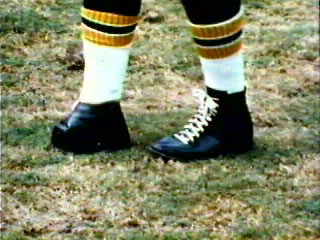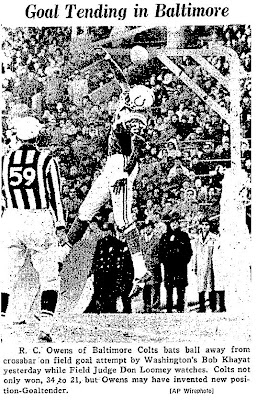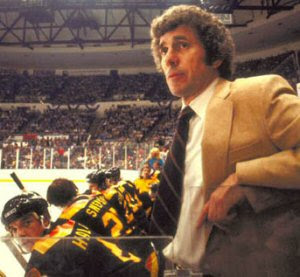At the highest levels of sport competition is intense and a tiny advantage can often times be the difference between winning and losing … not to mention the difference between being back home working construction or making millions of dollars a year playing a game. With that in mind it’s no surprise that athletes are more than willing to bend the rules when the opportunity presents itself. Here are nine athletes who might not have technically been crossing the line … but they were certainly going right up to the edge, often resulting in rule changes for their sport.
9. Steve Watson
Steve Watson was a defender/midfielder who spent most of his long career playing for Newcastle United and it was during his best years in the 1990s when he pioneered a technique to enhance the mere formality of the boring and lame throw-ins that always seem to break the flow of a good soccer match. The throw-in, what can be thought of as a hairy wart on the face of the beautiful game, is designed to be little more than a pass back into the field of play, much like throw-ins in basketball. The rules state that a player must always use both hands to throw the ball and have both feet on the ground at the point of release, restrictions most players were content to follow. Watson however wanted to turn the non-event of a throw-in into a legitimate offensive weapon that followed the letter of the law while brutally violating the spirit of the rule in the visitor’s locker room. Sometime in the early 90s, Watson demonstrated what would become his specialty, the Somersault Throw-in. He ran up to the boundary, performed a forward somersault with the ball still between his two hands and supporting all of his weight, then launched it from behind his head as soon as his feet contacted the ground. The stunning flourish not only looked really cool, but also gave the ball far more power and momentum than a stationary throw-in would have which allowed Watson to bypass defenders and position the ball very close to the opposing goal, much like a corner kick or other set piece. It was subsequently banned by FIFA, but several other athletes have since performed the technique in various other leagues where it still remains legal.
8. Tom Dempsey
Tom Dempsey was a placekicker in the NFL for ten seasons and is best remembered for his record shattering 63 yard field goal in 1970, a feat only matched once in the last 40 years. While an almost impossible feat by itself, his accomplishment becomes unimaginable when one notes that Dempsey was born without any toes on his right foot, a handicap which for most people would make kicking anything accurately, let alone a misshapen American football, out of the question. Dempsey however considered his missing toes an advantage as this not only saved him money on pedicures, but also allowed him to use a special shoe that terminated in a wide, squared off steel horseshoe rather than the soft, rounded point other kickers were stuck with. Without a pesky toe point to worry about, Dempsey was able to kick balls straight on (as opposed to the more popular side-footed “soccer style” kickers use today) using his full power without any worry of pulling or hooking it outside of the goalposts. After some controversy about Dempsey’s custom shoe being an advantage or not (it was), the NFL officially made a rule against it in 1977 that required all kickers to use a normal shoe whether they were toeless or not.
7. Eddie Gaedel
Eddie Gaedel was a little person (read: midget, dwarf, Danny DeVito) who played in Major League Baseball for exactly one day under a contract given to him by the owner of the St. Louis Browns in 1951. Gaedel, who stood barely 3 feet 7 inches tall, played with the jersey number “1/8” and debuted in a game against the Detroit Tigers to the ballpark’s shock and delight. With a signed contract and approved roster from the team manager to back him up, Gaedel – who looked more like an adorable member of the Little Rascals than a major league slugger – was allowed to bat. Of course he was walked in four straight pitches since it’s almost impossible for any pitcher to hit Gaedel’s impossibly small strike zone that spanned a meagre 1.5 inches. For those keeping track at home, that’s narrower than the diameter of the baseball itself. Gaedel seemed to have found his calling as the secret weapon of the Browns that would buy them a few free bases every game, but as he celebrated his first at bat in a professional Baseball game, League president Will Harridge stepped in and crushed the Lillputian’s major league hopes and dreams. Stating that Browns owner Bill Veeck and Eddie were making a mockery of America’s pasttime, he voided Gaedel’s contract the day after the game and a new rule was rushed into place that required all future contracts to be reviewed by the Commissioner of Baseball before potential players would be allowed to appear in a game. Gaedel eventually got his own back however as his autograph is currently more valuable than that of homerun factory Babe Ruth and his jersey is forever enshrined in the Baseball Hall of Fame, despite his only appearing in that single game.
6. R.C. Owens
R.C. Owens was a lankey, long armed wide receiver in the NFL from 1957-1964 who happened to also play amateur basketball as tall black athletes are wont to do. He was also notable for being able to jump extremely high, usually over the heads of defenders in order to catch what he pioneered and called the “alley-oop pass”, which was essentially the precursor to today’s “jump ball” that made Randy Moss such a dominant player. Recognizing Owens’ froglike jumping ability and tentacle-like appendages, the Baltimore Colts stationed him in the endzone directly underneath the goalpost during opposing teams’ field goal tries rather than the usual spot on the line of scrimmage which was customary. The impetus for such an unorthodox maneuver was to allow Owens to be in better position to act as a goalkeeper and block potentially low sailing balls from going over the crossbar, thus denying the kicking team their usually uncontested three points. Owens was successful in blocking a field goal using this tactic in 1962 which led to a new rule being instated the following year to prohibit such game breaking stratagems.
5. Roger Neilson
Behind every creative and infamous rule-bending player is a loophole loving coach; the most famous of which being NHL legend Roger Neilson. Neilson was a brilliant skipper who commanded the reins of no less than eight different professional ice hockey teams during his illustrious 26 year career. He not only pioneered the use of a once brand new technology called “videotape” to study opposing teams before each game, but also had a habit of studying the rule book in an effort to find various loopholes and technicalities to employ during matches. He is known for a few game breaking rule bends including the use of a defenseman instead of a goalkeeper during penalty shots since the official rules didn’t say he had to specifically employ a goalkeeper in the net, which freed up that defenseman to rush/attack the shooter completely disrupting any chance he may have had at hitting the tiny goal. On other occasions, he’d replace the apparently useless goalkeeper with an additional offensive player causing an imbalance of free skating athletes in favor of his team; though as you may have figured out already, that maneuver would have left his team’s goal completely open and undefended. Neilson got around that potential hiccup by instructing the replaced and exiting goalkeeper to “accidentally” leave his large hockey stick on the ice in front of the goal line in order to block the puck from entering the net should the other team be so silly as to actually take a shot at the goal. Both tactics led to subsequent rule changes since they sort of circumvented the entire point of goalkeepers in ice hockey.
4. Greg Pruitt
Greg Pruitt was an NFL Hall of Fame running back and was an integral part of the Raiders’ Super Bowl XVIII winning team in 1983. Pruitt fit right in with owner Al Davis’ philosophy of “Just Win, Baby”, the mantra for all creative rule benders the world over. Part of Pruitt’s phenomenal success in the league is largely credited to his deliberate use of flimsy, tear-away jerseys that were designed to fall apart any time a would be tackler tried to take him down, allowing him to continue running toward the endzone unimpeded as bewildered defenders stared in disbelief at what used to be Pruitt’s clothes. Once the NFL realized that the wardrobe malfunctions were intentional, they banned the use of tear-away jerseys and other flimsy articles of clothing in a rule named after Pruitt in order to preserve that whole tackling thing that was so central to the sport. Besides, no one wants to see a half naked dude running free as other men desperately grab hold of whatever they possibly can just to get him to the ground.
3. Wilt Chamberlain
Besides being a dominant force in the bedroom where he claimed to have slam dunked 20,000 women, Wilt “The Stilt” Chamberlain was a legendary god of Basketball throughout his 14 year career on the hardwood. Though he was superior in all phases of the sport to the point that the NBA made new rules just to slow him down, Chamberlain did have a weakness and he was very aware of it. Knowing his only weakness reared its ugly head when he was forced to shoot free throws from the line, he figured it’d be easier to just dunk the ball rather than trying to shoot it. To wit, he would stand at the top of the key a few feet behind the free throw line, heave the ball up toward the basket, take two strides, jump toward the rim and jam the ball through the net, essentially making his free throw percentage somewhere around 100%. And because the existing free throw rules at the time never said one specifically had to shoot the ball, Chamberlain’s loophole was as sound as the saga of his prodigious penis. However, the free throw rules were changed soon after to state that a player cannot cross the plane of the free throw line at all when taking the free shot, thus forcing Chamberlain to actually throw the basketball toward the net as originally intended.
2. Rob Ray
Rob Ray was a prototypical bar room brawler who, like all toothless bruisers and thugs, was allowed to play professional ice hockey in the NHL. As evidenced by his staggering 3,200 career minutes spent in the penalty box, Rob Ray loved to fight and acted as if this whole hockey business with its rules was getting in the way of his kicking the tar out of anyone stupid enough to pick up a stick; because as everyone knows, brawling is what hockey is really all about. To this end, he intentionally wore loose fitting pads and clothing so that when the inevitable sanctioned scrap broke out, he was able to shed his accoutrements speedily which gave him the ass beating advantage over his bulky, armor wearing opponent who was slow and restricted. His bare chested tactic became such an issue to the league that after the NHL instituted a rule named after Ray that thenceforth required players to keep their clothes on, pundits observed that “the league was horrified at the sight of a half-naked man flailing away at an opponent with roundhouse rights and straight-ahead lefts while crowds roared in delight.” You just have to love a sport where not only are fisticuffs just a part of the game, but that a half naked man actually has the advantage.
1. Lester Hayes
Belonging to the same Super Bowl winning and borderline cheating team as clothing hater Greg Pruitt, Lester Hayes was an NFL cornerback for the Oakland Raiders from 1977 – 1986 and is considered one of the best shutdown corners ever to play the game. He still holds the Raiders team record for career interceptions of 39 total, with 13 coming in a single season (also a record). His success as a player is thanks in no small part to his most famous contribution to NFL history: the liberal use of an adhesive substance called Stickum; and by liberal, we mean he practically bathed in it. Hayes, being covered in what is ostensibly industrial strength glue made sure that any time a football, offensive player, insect, low flying bird, or just about anything else came anywhere near his body, it’d stick to him like white on rice, making the football very easy to pick off from hapless receivers. Hayes’ record amount of sticky fingered interceptions in 1980 prompted the NFL to finally ban the use of Stickum and any other adhesives during official play with a rule named after Hayes in 1981. That’s right, the NFL actually had to make a rule to stop players from covering themselves in glue before every game; No Fun League indeed.
Matthew Hayden (not the Australian Cricketer) is an experienced freelance sports and comedy writer and all around great guy. You may have seen his work at Cracked, Gunaxin, and now of course SoccerLens, assuming you read the above article instead of simply scrolling to the end. You can contact him at matt.hayden@ukonline.co.uk
Add Sportslens to your Google News Feed!







